Many-faced pyrethrum, or Persian chamomile
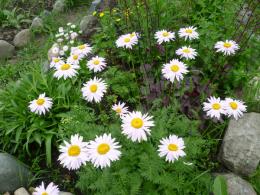
Pink feverfew, or Persian chamomile, has a related species, meat-red feverfew, with which it is often confused. Both plants belong to the Asteraceae family and are very similar in appearance - large inflorescences are like those of an ordinary chamomile, but the reed petals are colored in rich shades of pink and red-crimson.
Persian chamomile grows under natural conditions in the foothills of the Caucasus and Transcaucasia; it was introduced into cultivation long ago and popular with gardeners more than two centuries. In places of natural settlement it is represented by numerous varieties, differing in size and color of flowers - from pale pink to rich, rich shades of crimson and burgundy. There are terry forms.
As a result of the work of breeders, many hybrid forms and varieties have been obtained, distributed throughout the globe.
Content:
Appearance
Persian chamomile is a perennial herbaceous plant with an average height of 50-70 cm, with a straight stem and pinnately dissected leaves of different sizes - larger at the base, and smaller and narrower along the stem. Pyrethrum blooms in basket-shaped inflorescences with a diameter of 3 to 6 cm, consisting of two types of flowers - reed and tubular.
The reed flowers are arranged in a circle and are painted in shades of pink, and numerous tubular flowers are collected in a dense core of juicy yellow color.It blooms in early or mid-summer, and in favorable conditions continues to bloom for up to two months.
To prolong flowering, fading inflorescences are removed. Pyrethrum forms a loose bush that grows using superficial rhizomes. It looks beautiful in mono-plantings and in mixborders with other perennials, but may require periodic renewal, since in severe winters and high humidity the plant “falls out” and its lifespan may be limited to several years.
To prevent Persian chamomile from degenerating, the plants are periodically divided and replanted, new ones are replanted or young seedlings are replanted. With such constant attention, the flower garden does not lose its attractiveness for a long time.
Thanks to its straight and fairly rigid stems and beautiful bright flowers, pink pyrethrum is in demand not only as an ornamental garden plant, but is also actively used as a cut flower. Looks beautiful in a bouquet made only from this plant, but harmonizes perfectly with other garden flowers, including the common daisy, other pyrethrums, coreopsis, echinacea and rudbeckia, as well as herbs and gypsophila.
Growing conditions
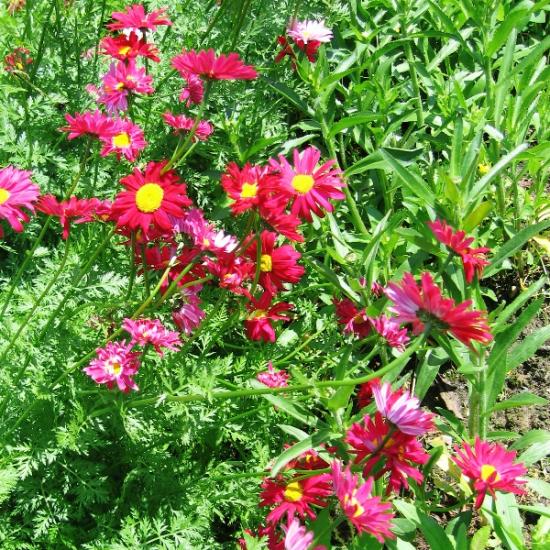
In places of natural distribution, this plant is accustomed to growing on fairly fertile soils without excess moisture, so in gardens it is planted in areas with good fresh soil, rich in nutrients, permeable and loose.
Skinny, dry and sandy soils are not suitable for pyrethrum - it will grow and bloom poorly, the inflorescences will quickly be crushed, the bush will wither and die.Also, low, flooded places are not suitable for chamomile - despite all the unpretentiousness of this plant, it will not survive prolonged soaking, especially in the cold season. In the right place in the garden, Persian chamomile will show itself in all its glory.
The plant is unpretentious to light and can grow well in partial shade, but for good lush flowering it needs sun. In the sun, the plant may suffer from drying out, but if you water it regularly, it will calmly withstand even a place exposed to the sun's rays.
The ideal option is an area illuminated by the sun part of the day, and slightly shaded the rest of the time. In such conditions, pyrethrum will exist for a long time.
Watering mode important for Persian chamomile, especially during the flowering period. With a chronic lack of water, flowering can sharply decrease and the plant itself weakens.
If you “flood” it, the superficially located roots will dry out and the bush may die. Uniform moderate watering guarantees good health, longevity and high-quality flowering of pink pyrethrum.
On poor soils, you can add well-rotted humus or compost. The plant has superficial roots, which are often exposed and dry out, so mulching the soil with humus not only feeds the chamomile, but also mulches the bushes. Mulch also protects the soil from drying out.
Persian chamomile is an unpretentious, fairly frost-resistant plant that decorates the garden all summer.
Planting and care
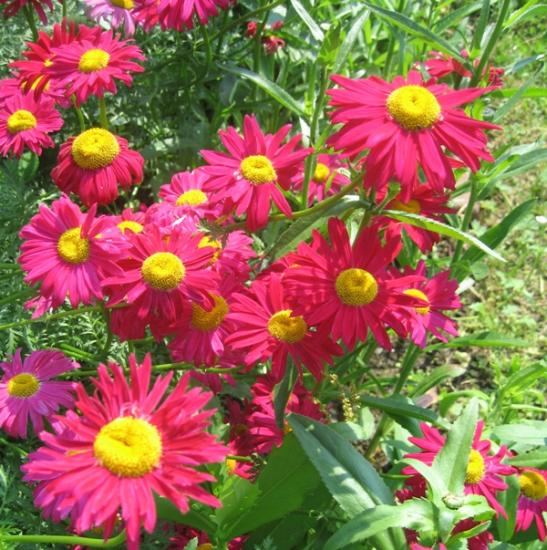
The plant reproduces in three ways:
- Dividing the bush
- Sowing seeds
- Self-seeding
Overgrown plants you can even share it with your hands. Each part should have strong, developed roots and several powerful stems.If the shoots are too tall and the plant does not hold well in the ground, they can be shortened - the pyrethrum will quickly recover and form a healthy, elegant bush.
Flowering with this method of division will occur in the year of planting. Divide the plant in the spring, when the green mass begins to develop and the buds are clearly visible. The cuttings are planted in a permanent place, and fertilizers can be added to the planting hole. Transplanted plants require regular watering, and in case of high temperatures and bright sun - shading.
Sowing seeds allows you to get many new plants or grow different varieties of pyrethrum. Seeds are scattered over the surface of the ground in boxes placed in warm rooms. They are covered with a thin layer of earth on top and watered. Warmth and regular spraying contribute to the production of friendly and strong shoots. The optimal sowing time is March.
The resulting seedlings placed in a cooler room, and the grown seedlings are gradually accustomed to the environment, exposed to the open air. After hardening, the seedlings are planted in a permanent place, protected from the scorching sun. Some of the seedlings will bloom this same year, the rest - the next.
Self-seeding is an easy way to produce large quantities of hardened seedlings. The last pyrethrum inflorescences are not cut off, but left to form seeds. When the seeds fall, they are stored in the ground and germinate in the spring, hardening naturally. Grown seedlings are dug up and replanted. The disadvantages of this method are that seedlings are scattered throughout the area, and different varieties are confused.
Pyrethrum is an easy-to-grow, unpretentious plant.
Persian chamomile planted in the garden will decorate it with beautiful bright flowers for a long time.In organic farming, pyrethrum powder is used to control pests.
Watch all about daisies in the video:
Interesting information about the vegetable garden

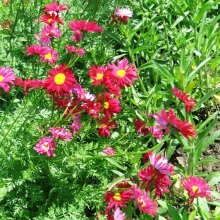
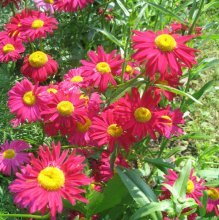
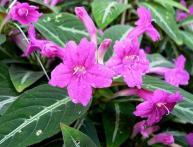
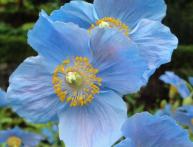

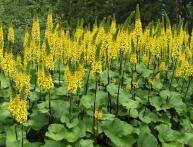
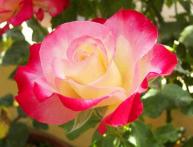
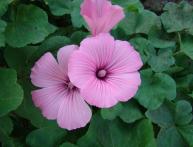
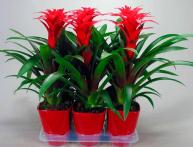
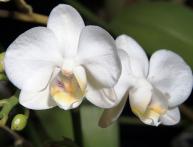
Comments
In the picture, these daisies look very beautiful. However, in reality there are not many flowers on one bush. They bloom for a long time and are well suited for garden decoration. They don't look very good when cut.